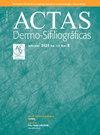[Translated article] Dermatology Update on the Challenging Trichodynia
IF 2.8
Q1 DERMATOLOGY
引用次数: 0
Abstract
Trichodynia is the sensation of pain in the scalp, which, in most cases, is associated with certain types of alopecia. Despite being a term coined by Rebora back in 1996 to described patients with diffuse alopecia consistent with telogen effluvium, this symptom has currently been reported in other entities. Androgenic alopecia, scarring alopecia, alopecia areata, trichotillomania, and chemotherapy-induced alopecia are common causes of trichodynia. Similarly, its association with psychiatric comorbidities, including depression, anxiety, obsessive-compulsive disorder and somatoform disorders has been reported with a higher prevalence among women. Although its pathogenesis is still to be elucidate, some factors involved are substance P, psychiatric comorbidities and perifollicular inflammation. Clinically it exhibits pain or discomfort of the scalp, almost always in association with hair loss. The sensation of pain can occur throughout the scalp or locally in some specific areas. Diagnosis is clinical and one of exclusion. Regarding treatment, there are no specific therapies for trichodynia. However, the use of botulinum toxin A, antidepressants, neuromodulators, propranolol, topical corticosteroids, oral corticosteroids and topical cannabinoids are therapeutic alternatives that should be taken into consideration. Since treatment of trichodynia is still therapeutically challenging for dermatologists more prospective studies are needed to evaluate new therapies.
对皮肤科医生来说,三联肌的更新是一个挑战。
毛痛症是头皮疼痛的感觉,在大多数情况下,与某些类型的脱发有关。尽管Rebora早在1996年就创造了一个术语,用来描述与休止期排出相一致的弥漫性脱发患者,但这种症状目前已在其他实体中报道。雄激素性脱发、瘢痕性脱发、斑秃、拔毛癖和化疗引起的脱发是引起毛痛症的常见原因。同样,据报道,它与精神合并症,包括抑郁症、焦虑症、强迫症和躯体形式障碍的关联,在女性中发病率更高。虽然其发病机制尚不清楚,但一些相关因素包括P物质、精神合并症和滤泡周围炎症。临床表现为头皮疼痛或不适,几乎总是与脱发有关。疼痛的感觉可以发生在整个头皮或局部的某些特定区域。诊断是临床和排除之一。关于治疗,目前还没有针对毛痛症的特异性治疗方法。然而,应考虑使用肉毒杆菌毒素A、抗抑郁药、神经调节剂、丙酚醇、局部皮质类固醇、口服皮质类固醇和局部大麻素作为治疗选择。由于头痛症的治疗对皮肤科医生来说仍然是治疗上的挑战,需要更多的前瞻性研究来评估新的治疗方法。
本文章由计算机程序翻译,如有差异,请以英文原文为准。
求助全文
约1分钟内获得全文
求助全文
来源期刊

Actas dermo-sifiliograficas
DERMATOLOGY-
CiteScore
1.90
自引率
9.40%
发文量
473
审稿时长
56 weeks
期刊介绍:
Actas Dermo-Sifiliográficas, publicación Oficial de la Academia Española de Dermatología y Venereología, es una revista de prestigio consolidado. Creada en 1909, es la revista mensual más antigua editada en España.En 2006 entró en Medline, y hoy resulta imprescindible para estar al día sobre la dermatología española y mundial.
 求助内容:
求助内容: 应助结果提醒方式:
应助结果提醒方式:


